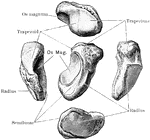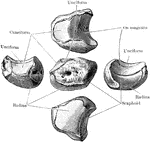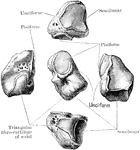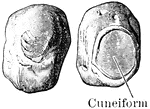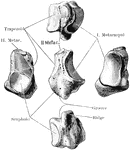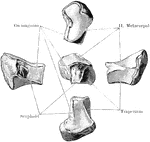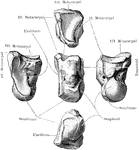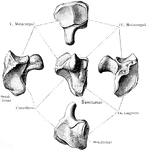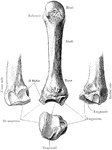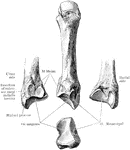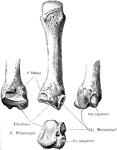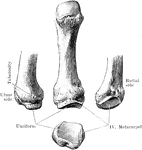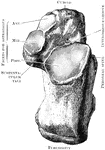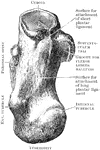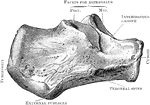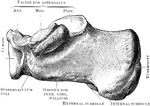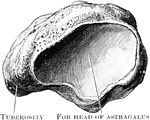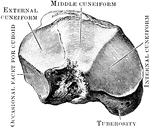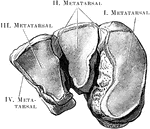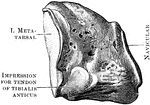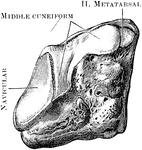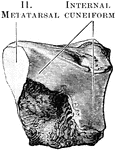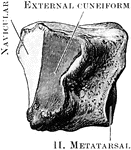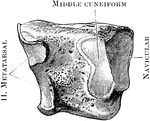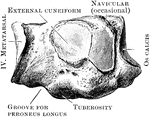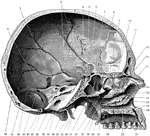
Skull Seen From Side
Shown is the inner aspect of the left half of the skull sagittally divided. Labels: 1, suture between…

Coronal Section of Skull
Shown is a coronal section passing inferiorly through interval between between the first and second…

Astragalus
The right astragalus. A, Upper surface. B, Under surface. Labels: 1, groove for flex, long, hallucis;…

Astragalus
The right astragalus. A, As seen from the outer side. B, As seen from the inner side. Labels: 1, external…

Metatarsal Bones
View of the bases and shafts of the second, third, and fourth metatarsal bones of the right foot.

Ligaments of the Occipital Bone
Dissection from behind the ligaments connecting the occipital bone, the atlas, and the axis with each…
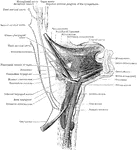
Muscles of the Hyoid Bone
The muscles of the hyoid bone and styloid process, and the extrinsic muscles of the tongue, with their…
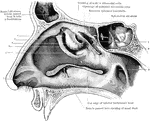
Outer Wall of Nose
View of the outer wall of the nose. The turbinated bones having been removed. Labels: 1, vestibule,…

Mesial Section Through Larynx
Mesial section through larynx, to show the outer wall of the right half.
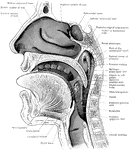
Section of the Head and Neck
Sagittal section through mouth, tongue, larynx, pharynx, and nasal cavity. The section was slightly…

Outer Wall of Tympanic Cavity
View of the outer wall of the middle ear. Section through the left temporal bone of a child to show…

Inner Wall of Tympanic Cavity
View of the inner wall of the middle ear. Section through the left temporal bone of a child to show…

Pike Scapulocoracoid
"Pectoral arch and fore limb of the pike (Esox lucius), an osseous fish, showing scapulocoracoid, composed…
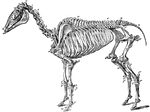
Skeleton of a Horse
The skeleton of a horse. Axial Skeleton. The Skull. Cranial Bones: a, occipital, 1; b, wormian, 1; c,…

Curlew Skull
"Schizorhinal skull of curlew (top view), showing the long cleft, a, between upper and lower forks of…

Horse Skull Seen from Above
The skull of a horse seen from above. Labels: I, occipital lobe; II, parietal bone; III, squamosal bone;…

Inferior Aspect of Horse Skull
Inferior aspect of horse's skull, the mandible being removed. Above the line A is the posterior region…

Lateral Aspect of Horse Skull
Lateral aspect of horse's skull. Labels: 1, occipital bone; 2, parietal bone; 3, frontal bone; 9, nasal…

Longitudinal Section of Horse Skull
Longitudinal section of a horse's skull. Labels: 1, supraoccipital bone and crest; 2, parietal bone;…

Hyoid Series of Bones in a Horse
The hyoid series is composed of five distinct pieces- a body, or hyoid bone proper, two cornua or horns…

Carpus of a Horse
Front aspect of the right carpus of a horse. Labels: 1, cuneiform; 2, lunar; 3, scaphoid; 4, trapezium;…
Horse Leg
External view of bones of right carpus, metacarpus, and digit of a horse. 1, distal end of radius; 2,…

Phalanges of a Horse
Posterior view of phalanges of a horse disarticulated. Labels: a, os suffraginis; b, os coronae; C,…

